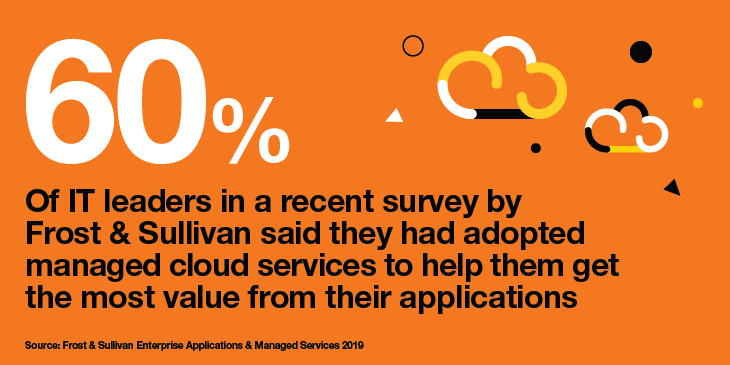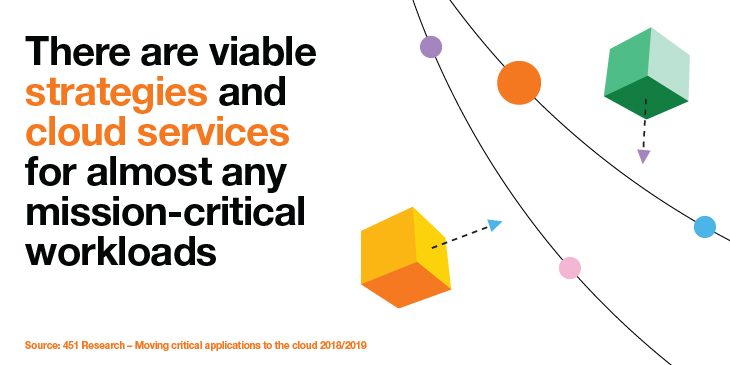The average large enterprise now has around 1,295 applications running in the cloud, many of which are business critical. There are now viable strategies and cloud services for almost any mission-critical workloads, according to 451 Research. The primary hurdles to migrating these critical applications to the cloud are predominantly organizational, and companies need to establish detailed planning and deployment for each specific scenario.
As an organization moves more and more of its critical workloads to the cloud, management also becomes unavoidably more complex. This is probably why 60% of IT leaders in a recent survey by Frost & Sullivan said they had adopted managed cloud services to help them get the most value from their applications. Only 3% of IT leaders said they do not think they will ever use managed cloud services.

Because many companies’ mission-critical data and applications also reside in their SAP or Oracle environments, selecting the right managed cloud service provider is paramount. Of those surveyed, 77% of IT leaders said finding the right partner to manage their applications and workloads and understand the business was a major challenge. The benefits reported of having the right partner were plain to see from those surveyed. While 60% considered the improved ability to deliver enhanced customer service a key benefit, 57% cited increased speed to market for new SAP and Oracle functionalities.
This highlights the importance of integration capabilities within a managed cloud services partner’s portfolio and an area that Orange Business focuses on. In fact, 80% said they needed to have a partner that could integrate their SAP and Oracle cloud apps with their in-house apps.
Understand your business-critical data
Moving business-critical applications to the cloud is essential for organizations that need to innovate and accelerate new technologies such as artificial intelligence (AI) and in-memory databases such as SAP HANA.
Organizations are now comfortable that they can migrate mission-critical applications with the minimum of disruption. Risk is less of an issue at the infrastructure level if organizations are adopting a cloud-native approach. In fact, the most significant danger is choosing a partner who can’t move away from traditional models, modernize and innovate.
To prepare for outsourcing mission-critical applications, organizations need to revisit their digital data strategy, look at their traditional application portfolio and identify the ones that need optimizing. Some applications can be modernized, some will be retired in the next eighteen months and new ones will come on board.
A strategy needs to be created for this data. Why? Because an organization’s current data strategy will not be compatible with a next-generation portfolio built with cloud-native tools – one where applications are designed to take advantage of cloud’s innate capabilities.
They need to work out the best way to build applications that will harvest the most value from this data. Organizations also need to look closely at next-generation revenue streams and where cloud-native can be incorporated in supporting microservices.
Going cloud-native stretches application management skills
It may be easier to carry out tasks on a one-on-one basis using cloud-native applications, but they are by their very make-up more complex to manage. The power to build and compete faster increases complexity. A legacy cloud application, for example, can be made up of three layers outlining functionality and deployment patterns, while a cloud-native application may have up to 500.
The more services running as part of an application, the more difficult they end up being to monitor and manage. To successfully manage critical business applications in a cloud-native environment, organizations must forecast how failure in one service will impact another. You also need to comprehend which failures will be the most critical.

An efficient and effective cloud-native monitoring strategy must be put in place to spot performance bottlenecks and any issues with microservices and infrastructures before becoming severe if business-critical applications are to run effectively.
Integration, again, is also an area that can cause difficulties, primarily because cloud-native applications comprise disparate services. Looking beyond the architecture of the application, successful integration also relies on choosing the right deployment solution.
This is an area where a partner like Orange Business can be invaluable in helping overcome the challenges of the cloud-native environment and tap into its agility, reliability and robustness. Orange does this by building cloud-native environments that have full visibility, full transparency and full codification.
Business-critical applications head to the cloud
Organizations that have not moved their business-critical applications to the cloud have found they have lacked flexibility in dealing with operational difficulties that the recent global health crisis has thrown at them. This has undoubtedly made more organizations look at moving their business-critical applications to the cloud if they haven’t already.
Successful application modernization is central to a successful cloud transformation. Outsourcing critical application management can drive down waste, reduce costs and increase the value of business-critical applications. It really is a no-brainer.

As a Chief Evangelist, Jan Aril focuses on sharing transparent and inspiring knowledge about his areas of expertise, such as public cloud, big data and AI, with the aim of helping companies take on a more sustainable innovation journey. He has more than two decades of experience in the IT-industry and has held positions from full stack development and sysadmin to C-level and board member. He works across the brands of Basefarm and Orange Business.